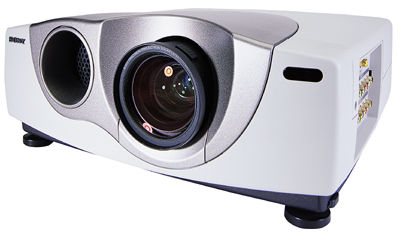Sony VPL-VW12HT LCD video projector

As before, the onboard scaling is Sony's Digital Reality Creation Multifunction (DRC-MF), which offers two options: DRCx4 (which produces the image in an interlaced fashion) and DRC-Progressive. A feature called CineMotion engages 3:2 pulldown; our tests indicated a more solid lock to the 3:2 sequence in DRC Progressive mode. A Cinema Black function reduces light output slightly and is said to improve black level while doubling the life of the projection lamp. Cinema Black provided plenty of light output, and I used it throughout the evaluation.
Many digital projectors—even ones far more expensive than the Sony—provide gray-scale adjustments that provide only overall control of red, green, and blue, not the more desirable ability to tweak both the high and low ends of the brightness scale. The Sony does provide these separate adjustments in its service menu. You can individually calibrate each of the selectable color temperatures: High, Low, and four custom settings. Full control of the VPL-VW12HT is available from the illuminated remote or on the projector itself. The remote is small, reasonably well-designed, and easy to use. In short, as far as I could tell, the VPL-VW12HT retains all the features of the 11HT, but sells for $1500 less.
There are, however, two new features: a filter for the projection lens that's said to improve contrast, and a feature called ImageDirector. The latter is a computer program designed to modify the projector's gamma settings—not only the overall gamma (many DVD players now provide some overall gamma adjustment), but separate gamma control for red, green, and blue.
Why is gamma important? The cameras and film-video transfer devices (telecines) used to produce program material are nonlinear devices. That is, the relationship between their input and output is not a straight-line function. To accurately reproduce this material, a video display must perform in a complementary (inverse) fashion. This is the first projector we have seen with such readily accessible control over gamma. But while the ImageDirector's manual describes the steps required to use the program, it provides no guidance whatsoever on why you might want to change the gamma, what to look for, or what tools you might need. In fact, proper setup of red, green, and blue gamma is not trivial and requires test equipment not likely to be possessed by the average owner. But not to worry; the factory gamma setup worked fine for me and I did not attempt to tweak it for this review. Still, ImageDirector is a feature unique in our experience to the VPL-VW12HT.
Setup
As with most digital fixed-pixel projectors, setting up the VPL-VW12HT was a snap. For a 16:9 image measuring 100 inches diagonally (87 inches wide), for example, simply position the 12HT between 10.7 and 12.4 feet from the screen, and adjust the manual zoom and focus. If the projector is positioned near the bottom (table mount) or the top (ceiling mount) of the screen, nothing more should be required except for perhaps a slight upward or downward tilt. Tilt can cause picture distortion (with the bottom of the picture wider than the top or vice versa), which can be eliminated by using the Sony's digital keystone correction control. Small keystone corrections don't appear to degrade the image, but I'd avoid projector locations that require extreme adjustments. As with all projectors, it's smart to compare the available throw distances with the parameters of your own home theater (screen size, possible projector locations, distance and height) before you make a purchase decision.
My review sample of the VPL-VW12HT was very quiet. The fan was loud for the first few seconds after turn-on, but dropped in level almost immediately. The noise was lowest with Cinema Black turned on.
On the Screen
Many of my observations about the performance of the VPL-VW12HT echo those I made about its predecessor, the VPL-VW11HT. It threw a very bright image. Say what you will about the advantages of the newest single-chip DLP and LCoS (including D-ILA) projectors—most of the ones we've seen were significantly less bright than this LCD, and only a few could approach or exceed it. This makes the Sony an ideal candidate for use with Stewart's FireHawk screen. While the FireHawk's rated gain is 1.35, our measurements show that its effective gain is actually lower than that of the Stewart StudioTek 130 (gain 1.3). Nevertheless, the Sony 12HT and the FireHawk were an ideal combination. The Sony had output to spare, at least on my 80-inch-wide screen, so I used the FireHawk exclusively for this review.
Apart from the desaturation that sometimes resulted from the projector's black-level limitations (more on this shortly), the Sony's post-calibration color quality was hard to criticize. Flesh tones looked natural and true, and apart from a slight orange shift in the reds—so common in video displays that I'm considering adding a sentence about it as a macro in my word processor—I found little to fault.
I did note two small color flaws. On black-and-white films, I could see faint traces of color in various areas of the screen, ranging from a hint of green to a hint of red. It was no more obvious than the slight color shifts you sometimes see in three-CRT rear-projection sets—so subtle, in fact, that I never noticed it on color films. But if you watch a lot of classic movies, you might want to check closely for yourself if this distracts you when you audition the projector.

























































